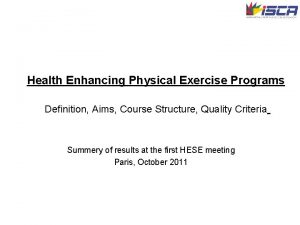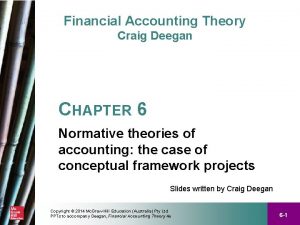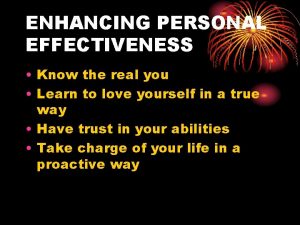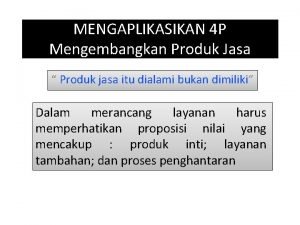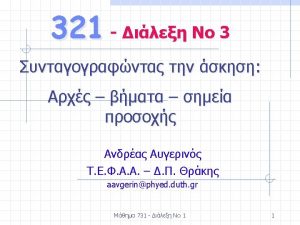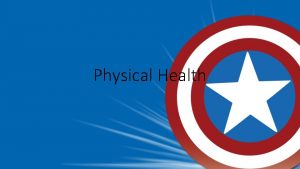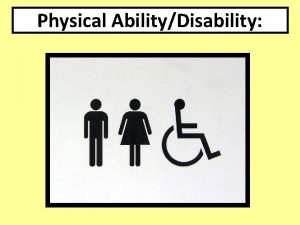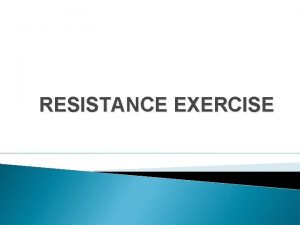Health Enhancing Physical Exercise Programs Definition Aims Course








- Slides: 8

Health Enhancing Physical Exercise Programs Definition, Aims, Course Structure, Quality Criteria Summery of results at the first HESE meeting Paris, October 2011

HEPA and HESE sport activities: What is this subject about? “The term <health-enhancing physical activity is frequently used in relation to the health benefits gained from physical activity. It should be understood as any form of physical activity that benefits health and functional capacity without undue harm or risk. … The main sources of health-enhancing physical activities encompass normal and simple activities such as walking, cycling, manual labour, swimming, skiing gardening, recreational sport, and dancing”. (WHO-Europe: Steps to health, 6).

Population based studies and some longitudinal studies show evidence • for preventive effects (reduction of risk factors of the metabolic syndrome); • for an improvement of the quality of life (better fitness, less complaints, better emotional status). But these studies also show that • everyday life activities are less effective than sport activities; • sport activities are less effective than sport exercise programs; • behavior change from sedentary to active behavior does not come about automatically.

The WHO document distinguishes between “physical activities” and “physical exercises”: “Exercise is a subset of physical activity, defined as planned, structured, and repetitive bodily movement to improve or maintain one or more components of physical fitness and health”. This differentiation is based on the fact that any form of physical activity contributes to better health. But special, structured, goal orientated programmes can provide better and more stabilized health effects.

What makes a HESE-Program? • It should follow basic core objectives: -Systematic strengthening of physical resources; -Improvement of psycho-social resources; -Coping with disorders; -Behaviour change to regular physical activities and healthy life-style.

A HESE-program …. . • …has to point out the health effects, strived for; • …has to define the target group (children; adults; seniors; gender; exercise experience; …) • …has to verify, that the content of the program/the activities can reach the health effects; • …has to follow a certain methodical structure (e. g. „Seven Sequencences“); • …has to be carried out by specially qualified instructors; • …has to consider some organisational demands: - limited size of the group; - sufficient duration of the program; - sufficient frequency of the program; - appropriate facilities and equipment

Target Groups for HESE Programs “Sedentary , unfit adults” “Active, fit adults” Health-Sport-Programs Fitness-Sport-Programs • • (1) Improvement of physical resources fitness (endurance, strength, flexibility, coordination, relaxation). (2) Improvement of psychological and social resources (motivation, knowledge, mood/fun, social competence, integration). (3) Prevention of risk factors and chronic degenerative diseases. (4) Improvement of coping competence. (5) Improvement of compliance with health directed physical activities (changing behaviour). (6) Creation of supportive settings (i. e. qualified teachers, networking with physicians) • • (1)Improvement of fitness endurance, strength, flexibility, coordination, relaxation – often focused). (2) Improvement of psychological and social resources (especially: mood/fun, motivation, integration). (3) Prevention of risk factors and chronic degenerative diseases.

Quality by structuring sport exercise programs: Sequences Health-Sport-Programs (90 min) Fitness-Sport Programs (60 -90 min. ) • • • 1. Opening Sequence (come together, heart rate, today's program, max. 5 min. ) 2. Warming-Up Sequence (games, low intensity motivating large muscle activities, max. 10 min. ) 3. Endurance Sequence (walking, jogging in variations/with music, max. 25 min. ) 4. Muscular Strength and Flexibility Sequence (max. 30 min. ) 5. Relaxation Sequence (max. 10 min. ) 6. Final fun & activating Sequence (max. 10 min. ) 7. Information Sequence (max. 10 min. , combined with one of the sequences 1 - 6) • • • 1. Warm-Up: 5 – 10 min. of low-intensity large muscle activities (e. g. walking, stretching). 2. Stimulus or Conditioning Phase Includes endurance, resistance & flexibility programming. 4. Recreational activities e. g. modified games to experience successful participation. 5. Cool-Down e. g. stretching, relaxation, yoga or tai chi exercises
 Health enhancing physical activity definition
Health enhancing physical activity definition National programmes related to child health and welfare ppt
National programmes related to child health and welfare ppt Overview of software engineering
Overview of software engineering Arraylist java exercises
Arraylist java exercises Four enhancing qualitative characteristics
Four enhancing qualitative characteristics Enhancing professional practice
Enhancing professional practice Charlotte danielson framework
Charlotte danielson framework Enhancing personal effectiveness
Enhancing personal effectiveness Contoh pengembangan produk jasa
Contoh pengembangan produk jasa
